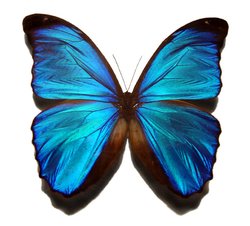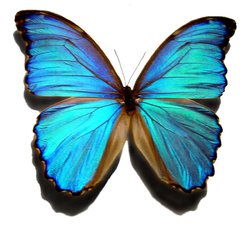Morpho (butterfly)
|
|
| Morpho (butterfly) | ||||||||||||||||
|---|---|---|---|---|---|---|---|---|---|---|---|---|---|---|---|---|
 Blue Morpho, Morpho menelaus | ||||||||||||||||
| Scientific classification | ||||||||||||||||
| ||||||||||||||||
| Species | ||||||||||||||||
|
M. godarti | ||||||||||||||||
 Morpho godarti |
A Morpho butterfly may be one of over 80 described species of the genus Morpho. They are showy, neotropical butterflies found mostly in South America with a few species recorded in southern Mexico and Mesoamerica. Morphos range in wingspan from the 7.5 cm (3 inch) M. rhodopteron to the imposing 20 cm (8 inch) Sunset Morpho, M. hecuba. The name Morpho derives from its use as an epithet of Venus.
Many Morpho butterflies are coloured in metallic, shimmering shades of blue and green. These colours are not a result of pigmentation but rather are an example of iridescence: the extremely fine lamellated scales covering the Morpho's wings reflect incident light repeatedly at successive layers, leading to interference effects that depend on both wavelength and angle of incidence/observance. Thus the colours produced vary with viewing angle, however they are actually surprisingly uniform, perhaps due to the tetrahedral (diamond-like) structural arrangement of the scales or diffraction from overlying cell layers. This structure may be called a photonic crystal. The iridescent lamellae are present on the dorsal side of their wings only, leaving the ventral side a drab brown.
The ventral side is decorated with ocelli or eyespots. In some species, such as M. godarti, the dorsal lamellae are so thin as to allow the ventral ocelli to peek through. While not all Morphos have iridescent coloration, they all have ocelli. In most species only the males are colourful, a fact supporting the theory that the coloration is used for intrasexual communication between males. The lamellae reflect up to 70% of light falling on them, including any UV. The eyes of Morpho butterflies are thought to be highly sensitive to UV light and therefore the males are able to see each other from great distances. Some South American species are reportedly visible by the human eye up to one kilometre away.
Morpho butterflies are forest dwellers but will venture into sunny clearings in order to warm themselves. Males are territorial and will chase any would-be rivals. The native peoples along the Rio Negro in Brazil once exploited the territorial habits of the Blue Morpho (M. menelaus) by luring them into clearings with bright blue decoys. The collected butterfly wings were used as embellishment for ceremonial masks.
Morpho butterflies feed on the juices of fermenting fruit with which they may also be lured. The inebriated butterflies wobble in flight and are easy to catch. Morphos will also feed on the bodily fluids of dead animals and on fungi. Morpho butterflies may be important by their role in dispersing fungal spores.
The hairy brown caterpillars are nocturnal and feed on a variety of leguminous plants. In some species the caterpillars are also cannibalistic, a trait thought to be a population control mechanism. If disturbed, Blue Morpho caterpillars will secrete a fluid smelling of rancid butter. The tufts of hair decorating the caterpillars irritate human skin.
The entire life cycle of the Morpho butterfly, from egg to death, is approximately 115 days. The adults live for about a month. Their predators are few for the adults retain poisonous compounds accumulated by the feeding caterpillar.
Today, Blue Morphos and similar species are reared en masse in commercial breeding programmes. The iridescent wings are used in the manufacture of jewellery and as inlay in woodworking. Mounted specimens are sold with the abdomen removed to prevent its oily contents from staining the wings. The lamellated structure of their scales has been studied as a model in the development of fabrics, dye-free paints, and anti-counterfeit technology such as that used in currency.
External links
- Insectia.com: Morpho butterfly profile (http://www.insectia.com/beta/e/iv_c202047.html)
- Quantified interference and diffraction in single Morpho butterfly scales (http://newton.ex.ac.uk/research/thinfilms/butterflies/morpho_paper.htm)
- Darkfield Gallery: Morpho butterfly wing (http://www.mic-d.com/gallery/darkfield/morphohigh.html)
- Singapore Zoological Gardens' Butterflies at the Zoo (http://www.szgdocent.org/ff/f-lep5.htm)
- BBC Blue Sky: Flights of Fancy (http://www.open2.net/bluesky/butterfly.htm)
- Stembol.com: Morpho butterflies (http://stembol.com/morphidae/index.htm)ja:モルフォ
